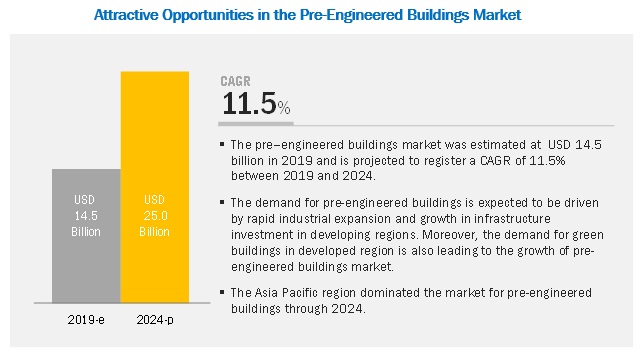
The pre-engineered buildings market is projected to grow from USD 14.5 billion in 2019 to reach USD 25.0 billion by 2024, at a CAGR of 11.5%. Factors such as the increasing demand for green buildings and need for reducing construction time and cost, along with the demand for lightweight building structure, drive the pre-engineered buildings market.
Request for sample report @ https://www.marketsandmarkets.com/requestsampleNew.asp?id=128289566
Recent Developments
- In March 2019, Nucor Corporation has planned to expand its steel plate production capacity by building a steel plate mill in Brandenburg, KY, US. The company has planned an investment of USD 1.35 billion in the mill. This mill has a planned production capacity of 1.2 million tons of steel products per annum. This is expected to strengthen the company’s steel plate product portfolio, which is further expected to support its pre-engineered buildings production, as steel plates are used as a raw material to manufacture pre-engineered buildings.
- In August 2017, Zamil Steel Pre-engineered Building Company signed a contract with Agility Kuwait to build four air-conditioned warehouses in Mina Abdullah, Kuwait. This contract was valued at USD 6.7 million. Under this contract, the company would provide 4,600 metric tons of pre-engineered steel buildings and over 100,000 square meters of sandwich panels.
Scope of the report
| Report Metric | Details |
| Market size available for years | 2017-2024 |
| Base year considered | 2018 |
| Forecast period | 2019-2024 |
| Forecast units | Value (USD) and Volume (Million Square Feet) |
| Segments covered | Structure, Application, and Region |
| Geographies covered | North America, Asia Pacific, Europe, South America, and the Middle East & Africa |
| Companies covered | BlueScope Steel (Australia), NCI Building Systems (US), Nucor Corporation (US), Kirby Building Systems (Kuwait), Zamil Steel Holding Company (Saudi Arabia), ATCO (Canada), Lindab Group (Sweden), PEBS Pennar (India), PEB Steel Buildings (Vietnam), and Everest Industries (India). Total 25 major players covered |
Asia Pacific accounted for the largest share in 2018 and is also projected to record the highest growth rate during the forecast period. The key factors driving the growth of the Asia Pacific pre-engineered buildings market are the growth in the residential and non-residential construction industry, huge investments in the infrastructural sector, and rapid industrialization in the developing countries of Asia Pacific. Furthermore, various benefits of these buildings, including time & cost efficiency and reduced environmental impact, as compared to cast-in-situ construction, are fueling the demand for these buildings in the developing countries of Asia Pacific.
Key Questions addressed by the report
- Which regions offer immense opportunities in the pre-engineered buildings market?
- What are the upcoming industry trends for pre-engineered buildings?
- What are the high-growth segments in the pre-engineered buildings market?
- What are the factors driving the growth of the market?
- What is the competitive scenario in pre-engineered buildings market?
Download PDF Brochure @ https://www.marketsandmarkets.com/pdfdownloadNew.asp?id=128289566